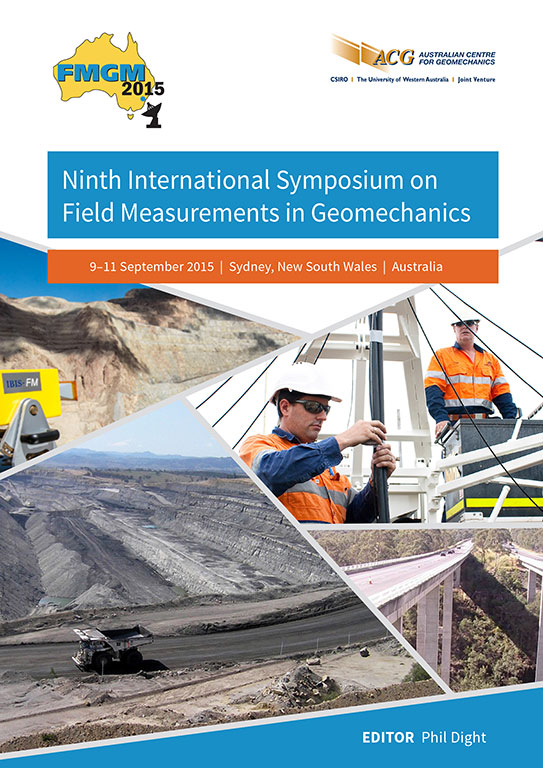Monitoring concrete segmental lining tunnels with fibre-optic and conventional instrumentation

|
Authors: Gil Lorenzo, S; Elshafie, M; Soga, K; Mair, R; Wright, P; Clegg, M Paper is not available for download Contact Us |
DOI https://doi.org/10.36487/ACG_rep/1508_24_Gil_Lorenzo
Cite As:
Gil Lorenzo, S, Elshafie, M, Soga, K, Mair, R, Wright, P & Clegg, M 2015, 'Monitoring concrete segmental lining tunnels with fibre-optic and conventional instrumentation', in PM Dight (ed.), FMGM 2015: Proceedings of the Ninth Symposium on Field Measurements in Geomechanics, Australian Centre for Geomechanics, Perth, pp. 373-384, https://doi.org/10.36487/ACG_rep/1508_24_Gil_Lorenzo
Abstract:
From the early days of tunnelling, developments in lining technology relied on laboratory testing and analyses of field monitoring data. This approach is still commonly implemented by designers to enhance their knowledge on lining performance and to, ultimately, develop, validate and optimise their assumptions, methods and solutions. Novel structural health monitoring techniques such as distributed fibre-optic strain sensing bring an excellent opportunity to capture global behaviour of concrete segmental lining by embedding fibre-optic strain sensors during the segment cast. Cambridge University, in collaboration with Hochtief (UK) Construction and Crossrail Ltd., has instrumented four rings in the newly constructed Thames tunnel. This has provided a complete set of in situ monitoring data on ring deformations sensed by both conventional and fibre-optic instrumentation. The monitoring regime was purposely designed to capture measurements during the construction process, including tunnelling and cross passage construction. The results will be used in the future to describe the real history of deformations, stresses and forces developed in concrete segmental lining in shallow tunnels excavated in chalk. In this paper, Brillouin Optical Time Domain Reflectometry (BOTDR) and vibrating wire strain gauge (VWSG) strain measurements are compared and discussed to validate the use of the distributed optical fibre sensing technique for concrete segmental linings.
References:
Bilotta, E & Russo, G 2012, ‘Backcalculation of internal forces in the segmental lining of a tunnel: the experience of Line 1 in Naples’, in J Viggiani (ed.), Proceedings of the Geotechnical Aspects of Underground Construction in Soft Ground Conference, Taylor & Francis Group, London, pp. 213-222.
Cheung, LLK, Soga, K, Bennett, PJ, Kobayashi, Y, Amatya, B & Wright, P 2010, ‘Optical fibre strain measurement for tunnel lining monitoring’, Proceedings of the Institution of Civil Engineers – Geotechnical Engineering, vol. 163, no. 3, pp. 119-130.
Davies, HR & Bowers, KH 1996, ‘Design and installation of special tunnel rings to monitor long term ground loading’, in RJ Mair & RN Taylor (eds), Proceedings of the International Symposium on Geotechnical Aspects of Underground Construction in Soft Ground, Balkema, Rotterdam, pp. 257-262.
Do, NA, Oreste, P, Croce, A, Dias, D, Djeran-Maigre I & Locatelli, L 2012, ‘Stress and strain state in the segmental linings during excavation by tunnel boring machines’, Proceedings of the 38th Annual Meeting of the International Tunnelling and Underground Space Association – World Tunnel Congress, Thailand Underground & Tunnelling Group, Bangkok, 8 p.
Dunnicliff, J 1993, Geotechnical instrumentation for monitoring field performance, Wiley-InterScience, New York.
European Standard 2004, BS EN 1992-1-1:2004 Eurocode 2: Design of concrete structures – Part 1-1: General rules and rules for buildings’, BSI Group, London.
Glišić, B & Inaudi, D 2007, Fibre optic methods for structural health monitoring, John Wiley & Sons Ltd, Chichester, West Sussex.
Hoult, NA & Soga, K 2014, ‘Sensing solutions for assessing and monitoring tunnels’, in ML Wang, JP Lynch & H Sohn (eds), Sensor technologies for civil infrastructures – vol. 2: applications in structural health monitoring, Woodhead Publishing, Sawston, Cambridge.
Lofgren, I 2007, ‘Calculation of crack width and crack spacing’, Proceedings of the Nordic Mini-Seminar on Fibre reinforced concrete, Trondheim, 12 p. Nordic Concrete Federation - Workshop proceeding no. 6: November 15th, 2007, 12 papers, 132 pages.
Mohamad, H 2008, ‘Distributed optical fibre strain sensing of geotechnical structures’ PhD thesis, Cambridge University.
Murayama, H, Kageyama, K, Shimada, A & Nishiyama, A 2005, ‘Improvement of spatial resolution for strain measurements by analyzing Brillouin gain spectrum’, Proceedings of the SPIE 5855 17th International Conference on Optical Fibre Sensors, vol. 5855, pp. 551-554.
Neville, AM & Brooks, JJ 2010, Concrete technology, 2nd edn, Pearson Education Ltd, Essex.
Rodrigues, C, Inaudi, D & Glišić, B 2013, ‘Long-gauge fibre optic sensors: performance comparison and applications’, International Journal of Lifecycle Performance Engineering, vol. 1, no. 3, pp. 209-233.
van Oosterhout, GPC 2003, ‘Recent Dutch experiences in developing structural monitoring systems for shield driven tunnels’, HERON, vol. 48, no. 1, pp. 65-78.
© Copyright 2025, Australian Centre for Geomechanics (ACG), The University of Western Australia. All rights reserved.
View copyright/legal information
Please direct any queries or error reports to repository-acg@uwa.edu.au
View copyright/legal information
Please direct any queries or error reports to repository-acg@uwa.edu.au